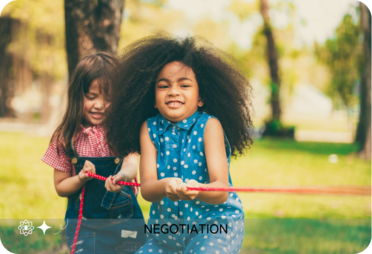A Visual Perspective on Conflict Mediation: Metaphors and Photographs
Conflict mediation is a complex process that often involves intense emotions, conflicting perspectives, and difficulties in communication. In this context, visual metaphors with photographs have become a powerful tool that can transform the way we approach and resolve conflicts. The Introspekt Method, based on the subjective interpretation of images and concepts, offers a unique platform to explore and resolve conflicts effectively and constructively.
- Expression of Emotions: One of the most challenging aspects of conflict mediation is allowing the parties to express their emotions openly and honestly. In this sense, the Introspekt Method allows participants to choose an image that reflects how they feel about the conflict in question. By using images instead of words, you reduce the threat and encourage more authentic expression. This dynamic can be especially useful for releasing repressed emotions and opening the way to more effective communication.
- Identification of Root Causes and/or Deep Needs: Many conflicts have underlying causes or unmet emotional needs that are not evident to the naked eye. Participants can select images that reflect what they believe is at the heart of the conflict. This dynamic promotes reflection and discussion on how to address these fundamental issues.
- Building Communication Bridges: Successful mediation involves building effective communication bridges between the parties in conflict. The Introspekt Method allows participants to choose images that symbolize their desire to build bridges of communication. By viewing and discussing these images, approaches can be explored to improve communication and relationship between parties.
- Neutral Perspective: Sometimes, parties in conflict are caught in extreme polarization, with no room for objectivity. In such cases, asking participants to choose neutral images, not directly related to the conflict, can help to distance them from confrontation and encourage objective reflection. This dynamic can be especially valuable in de-escalating tension and promoting a more even-handed approach toward conflict resolution.
- Exploring Compromise: Conflict resolution often involves a willingness to make concessions and find a middle ground. Participants can choose an image that reflects their willingness to compromise and work together to reach a mutually beneficial solution. This dynamic promotes a collaborative attitude and a willingness to compromise in non-essential areas of the conflict.
- Empathy and Perspective: One of the main advantages of visual metaphors is their ability to foster empathy and understanding of others' perspectives. Participants can select images that represent their commitment to understanding the other party's needs and concerns. Doing so promotes an environment of active listening and mutual respect, which is essential in conflict mediation.
- Identification of Common Interests: The identification of shared interests is essential to find sustainable solutions to conflicts. Participants can choose an image that reflects the interests they have in common and discuss how they can work together to achieve those goals. This dynamic highlights the importance of finding common ground and seeking solutions that benefit both parties.
- Consequence Analysis: Understanding the possible consequences of decisions is essential in conflict resolution. Participants can select images that represent the possible consequences of their choices and discuss how to avoid undesirable outcomes. This dynamic encourages informed decision making and consideration of long-term implications.
- Creative Conflict Resolution: This method also allows participants to explore creative solutions and possible positive outcomes. By choosing images that represent innovative solutions, conflicting parties can work together to develop a plan that meets their needs and expectations. This dynamic is especially effective in finding solutions that go beyond initial positions and satisfy the underlying interests of both parties.
In summary, these tools & techniques offer a unique and effective approach to conflict mediation through visual metaphors and photographs. By allowing participants to express their thoughts, emotions and perspectives through images, a safe and open space for conflict resolution is created. This methodology not only breaks the pattern of confrontation, but also encourages a more constructive approach toward conflict resolution. Images become powerful tools for empathy, effective communication and creativity in the search for solutions. In a world full of conflicts, the Introspekt Method is presented as an innovative way to transform dynamics and find mutually satisfactory solutions.

